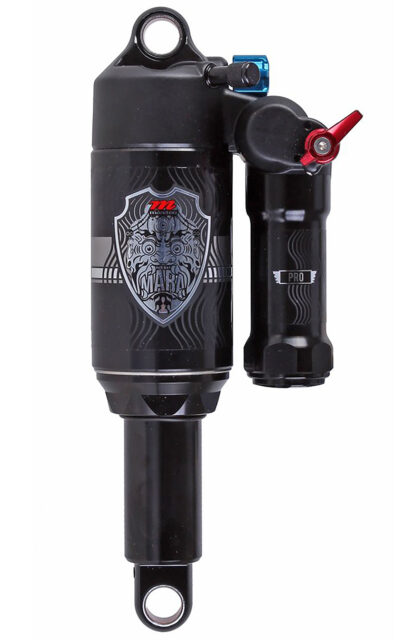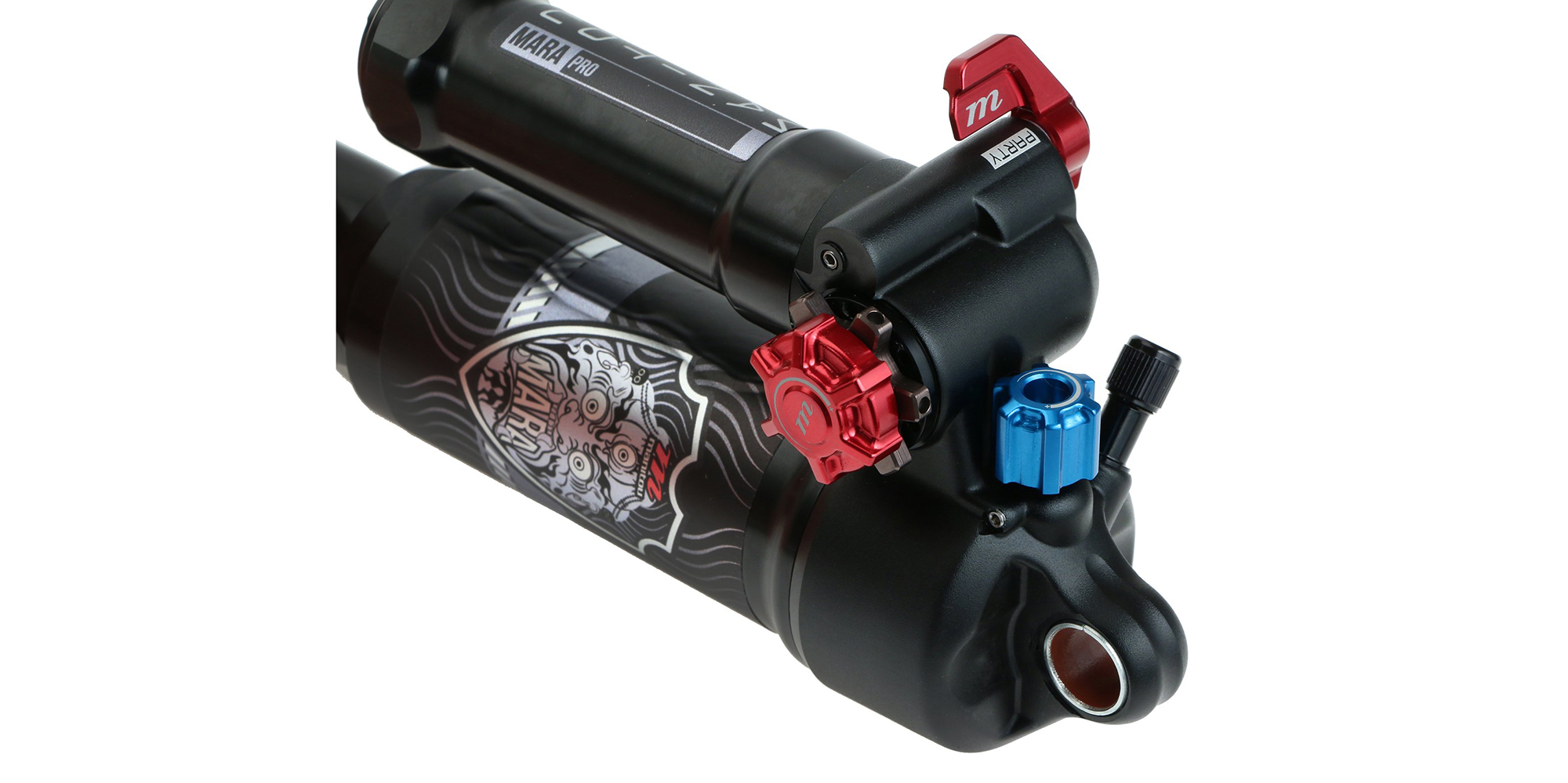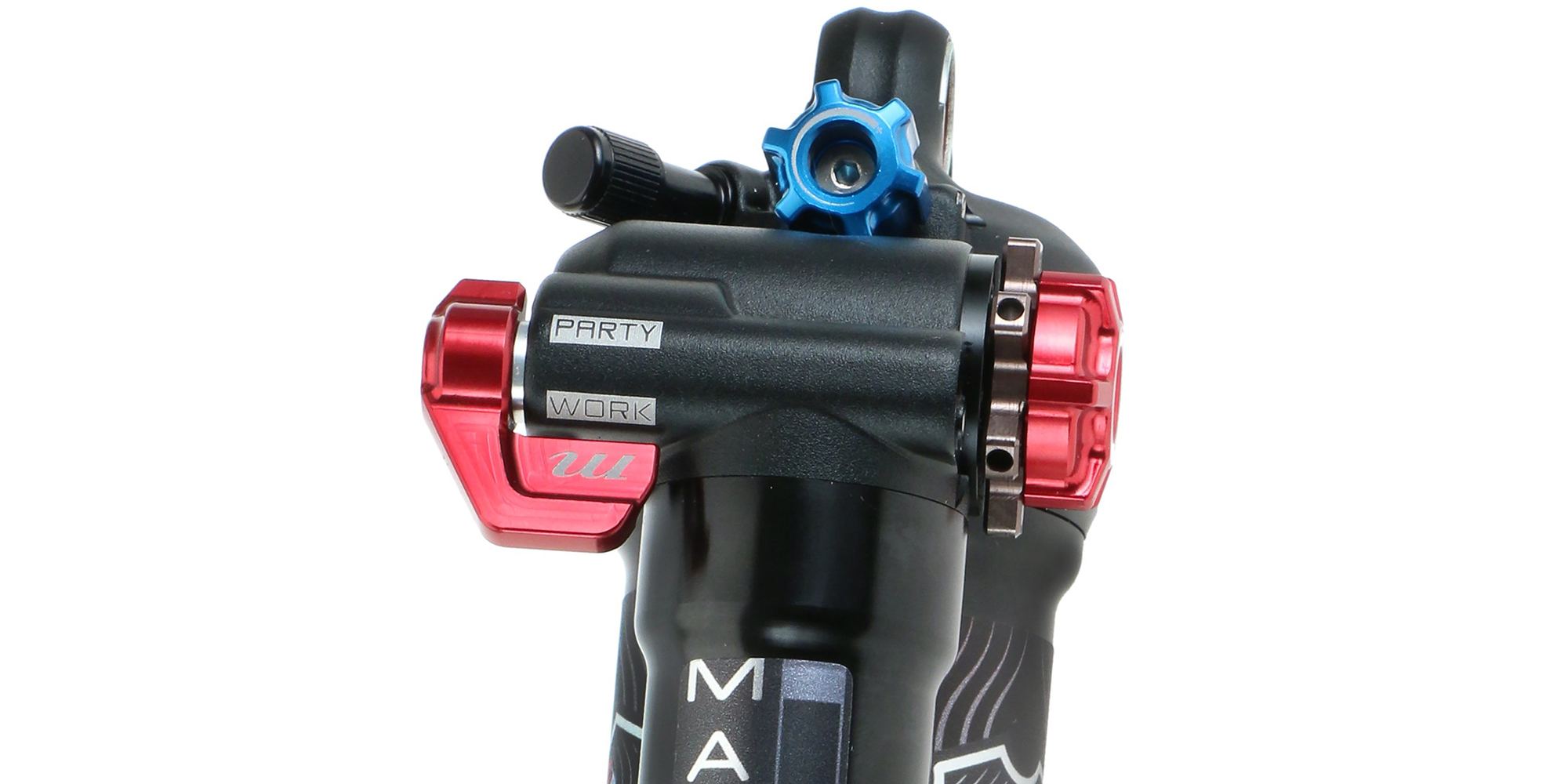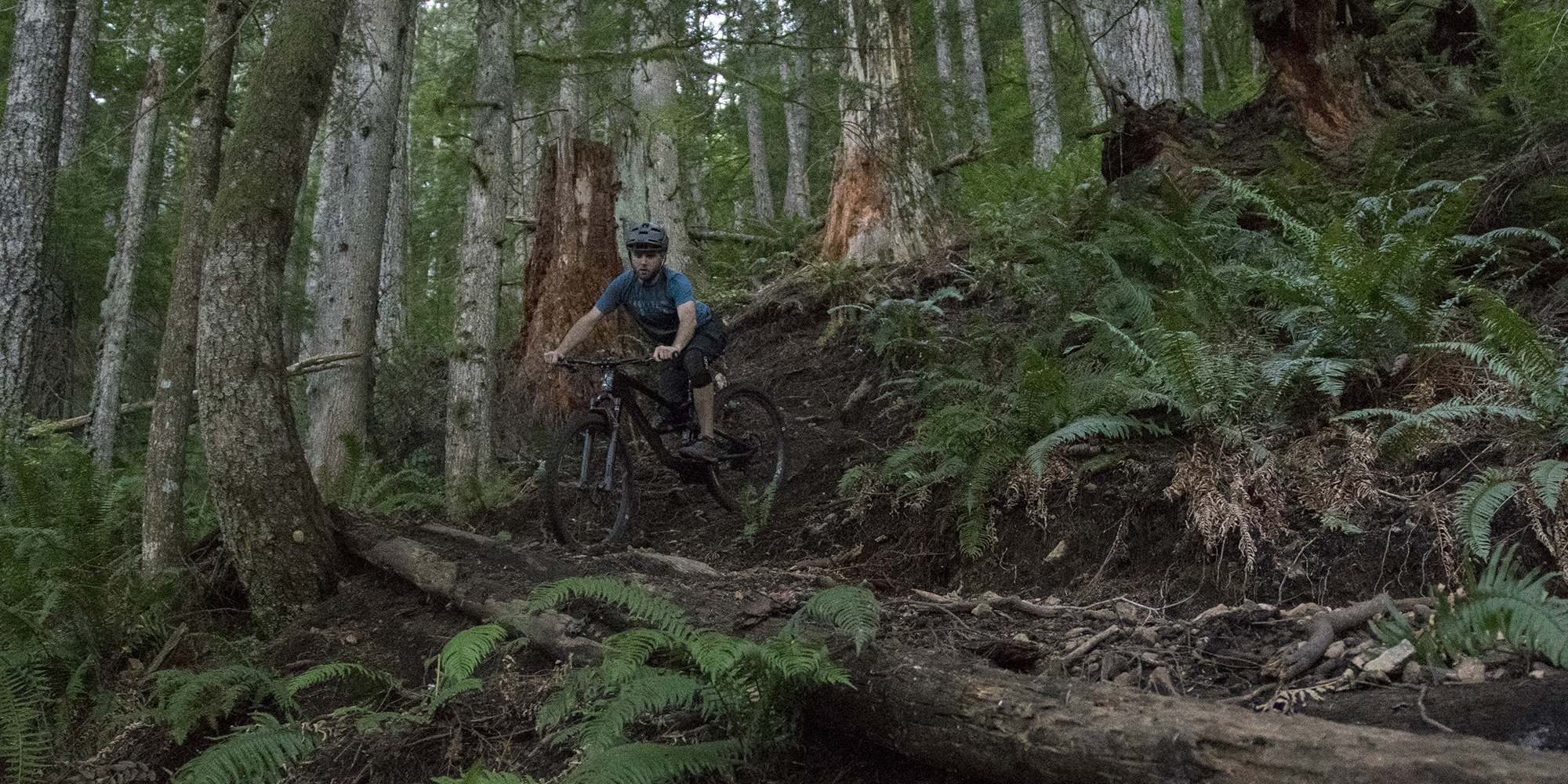Manitou Mara Pro Shock
Reviewer: 6’, 165 lbs / 183 cm, 74.8 kg
Test Location: Washington
Test Duration: ~3 months
Bolted to: Guerrilla Gravity Gnarvana
Size Tested: 230 x 65 mm
Blister’s Measured Weight: 603 grams
MSRP: $580 USD
- 7.875 x 2.25”
- 8.5 x 2.5”
- 8.75 x 2.75”
- 9.5 x 3.0”
- 190 x 40 mm
- 190 x 45 mm
- 210 x 50 mm
- 210 x 55 mm
- 230 x 60 mm
- 230 x 65 mm (tested)
- 250 x 70 mm
- 250 x 75 mm
- 165 x 40 mm
- 165 x 45 mm
- 185 x 50 mm
- 185 x 55 mm
- 205 x 60 mm
- 205 x 65 mm
- 225 x 70 mm
- 225 x 75 mm

Intro
I tested — and loved — Manitou’s long-travel single-crown fork, the Mezzer Pro. I have also been spending time using the Manitou Mara Pro, which is the rear shock meant to pair with the Mezzer.
The Mara Pro is an air-sprung shock, aimed at the Trail / Enduro market, and features some unusual design details. But how does it work on the trail, and how does it perform compare when matched with the excellent Mezzer Pro? Let’s dig in.
The Design
At first glance, the Mara Pro looks fairly conventional — it’s an air shock with a piggyback reservoir for the damper and features high- and low-speed compression adjusters, a single rebound adjustment, and a climb switch. The compression knobs are large and feature large ridges, making them easy to turn with a gloved hand.

Like most modern air shocks, the Mara Pro offers a degree of adjustability to the air chamber volume, but the range of adjustment is uncommonly large, and uses two different means of adjustment, rather than simply using volume spacers alone.
[Fair Warning: I’m going to get pretty into the weeds here discussing the Mara Pro’s design, since it’s a big part of why it performs differently on the trail than many other shocks. But if you want to just skip to the on-trail performance, you can use the “Review Navigation” bar up top.]
The Mara Pro’s first, large-scale adjustment actually uses an o-ring to entirely seal off a portion of the air can. With the o-ring removed, the air can is at its maximum volume; install the o-ring, and the volume is reduced substantially. More conventional volume spacers can also be used to fine-tune the volume, with or without the o-ring in place.
The air can is opened by removing a snap ring, and then sliding the can down the shock body (after relieving the air pressure, of course). No tools are required, and air-volume adjustments can be performed on many bikes without removing the shock. The larger-volume “King Can” comes standard on the Mara Pro, but a smaller-volume air can is also available if desired.
The negative spring of the Mara Pro is also unconventional. Unlike most modern air shocks, the Mara Pro doesn’t use a self-equalizing negative spring to set identical pressure in the positive and negative chambers at topout. Manitou argues that the most common method for doing so — a small dimple machined into the shock body, so that air is able to bypass the air-piston seal at topout — is disadvantageous because it creates a flat spot in the spring curve, where the spring doesn’t normally begin to work until it has compressed enough to close off the aforementioned dimple.
While there’s some truth to that, the solution Manitou came up with to get around it in the Mara Pro also has its downsides. Unlike the Mezzer Pro, which equalizes pressure between the positive and negative chambers when a shock pump is attached, the Mara Pro runs a fixed negative spring pressure. Essentially, the air can is meant to be assembled with the shock fully compressed, so that the negative chamber is at atmospheric pressure when the shock is bottomed out — i.e., the position when the negative chamber is at its highest volume. As pressure is added to the positive chamber, the shock extends, and the negative chamber decreases in volume, thereby increasing its pressure, until the pressure in the positive chamber is great enough for the shock to extend to its full length. I’ll get into how this matters on the trail more below, but the upshot is that the negative spring in the Mara Pro doesn’t adjust for different positive pressure settings, unlike most other shocks on the market.

[Aside on Negative Springs: If a refresher on what a negative spring is and how it works would be helpful, I’ll do a quick rundown here. In an air-sprung fork or shock (for brevity, I’m just going to say “shock” in the rest of this section, but it applies to both), the main air chamber is referred to as the positive spring. It serves the same function as the coil spring in a shock that uses one — it’s the spring that supports the weight of the rider and the bike, and provides the force to rebound the shock from its compressed state. Air shocks, however, add a second spring to the picture — the negative spring. The negative spring is more commonly a second air spring; i.e., another chamber of compressed air, though sometimes a coil spring is used. The negative spring’s function is to oppose the main / positive spring, mostly at the top of the stroke, predominantly in the name of improving small-bump compliance.
The negative spring works exactly opposite to the positive spring: as the shock is compressed, the negative spring extends, and vice versa. In the case of an air negative spring, this means that its volume is lowest (and therefore, its pressure is highest) when the shock is topped out / fully extended, and its volume increases (dropping the negative spring pressure) as the shock is compressed. The effect of the negative spring is therefore highest at topout, and mitigates as the shock compresses.
The need for a negative spring in an air shock comes down to the fundamentally different behavior of an air spring vs. a coil spring.
A coil spring has a fixed length in its “relaxed” (i.e. unloaded / unweighted) state, and at that length, it exerts no force to extend itself. If you remove the spring from a coil shock, it doesn’t try to extend longer until it runs into the opposite walls of your garage. That’s what the compressed air in an air spring wants to do, though, so it is exerting force to extend the shock, even at the fully extended position. A negative spring that counteracts this force early in the travel, to better emulate the behavior of a coil spring, greatly improves the performance of an air shock.
Unlike most modern shocks, the Mara Pro’s negative spring doesn’t self-adjust to match the changing air pressure in the positive spring, so the degree to which it balances the forces at topout is mitigated substantially — especially at higher positive-spring pressures. Below I’ll go more into how this plays out when you’re actually riding the Mara Pro.]
Ok, back to the Mara Pro. Its damper is a mono-tube design, like the majority of mountain-bike rear shocks, but has a few tricks up its sleeve as well. Perhaps most interesting is the design of the Mara Pro’s internal floating piston (IFP) that’s used to compensate for the displacement of oil through the shock as it cycles. While the layout of the IFP in the Mara Pro’s reservoir is conventional, the piston itself is a bit different than most. The center of the Mara Pro’s IFP is made of a stretchy rubber, with the idea being that the shock can start moving (and thereby displace oil through the damper) without the IFP itself starting to move.
The goal here is to reduce breakaway friction — if the shock can start moving without needing to overcome the static friction in the IFP (because the IFP can stretch, rather than slide, to accommodate the first bit of motion), the amount of force needed to get the shock to start moving is reduced. It’s a clever idea, and the Mara Pro is impressive in how low-friction it feels, especially for an air shock.
The Mara Pro’s climb switch (the two positions of which are, amusingly, labeled “Work” and “Party”) is large and easy to actuate, and sits on the side of the shock body for easier access. The switch routes oil flow through a dedicated circuit, instead of adding preload to the standard compression valving, which is an increasingly common design that’s shared with the EXT Storia Lok V3 and 2021 Fox Float X2 and DHX2, among others. The advantage of such a design is that it allows the climb switch valving to be configured independently from that of the shock in open mode, and therefore creates more tuning possibilities for configuring the shock.

Speaking of tuning, Manitou has made the Mara Pro’s main compression valve accessible without fully disassembling the shock, so that it can be re-valved quickly and easily — even potentially by an end-user with basic tools and a bit of know-how. A complete rebuild is doable at home as well, albeit with a few more tools and some extra effort, and Manitou has very good service instructions posted on their site.
Climbing
Put simply, the “Work” mode on the Mara Pro is excellent. When flipped into Work mode, the shock offers very firm compression damping at lower speeds, but opens up on harder impacts (or if you forget to switch it for a descent, which I definitely did for testing purposes and definitely not by mistake). The Mara Pro does an especially good job of holding firm under pedaling inputs, but opening up under heavier impacts, to maintain traction when needed.
The “Work” mode is notably firmer overall than the climb modes on most shocks I’ve been on recently, but I think that’s largely a good thing — you don’t have to use the climb mode any time you’re climbing, after all — and making it quite firm and letting riders leave the switch off for circumstances where more traction is needed seems sensible. And of course, it’s possible to re-tune the climb switch valving independently of the main compression circuit, if needed.
Descending
While the out-of-the-box tune of the “Work” mode on the Mara Pro is excellent, I had a harder time dialing in the setup of the shock for the way back down in “Party” mode. I largely put it down to the unconventional air-spring layout described above.

Starting with the Mara Pro’s compression adjusters in the middle of their ranges, the air can set to the mid-volume setting (o-ring installed, no additional volume spacers), and the recommended 125 psi, the Mara Pro’s small-bump compliance was reasonable, if not outstanding, and I was able to use full travel reliably without bottoming harshly. But the midstroke support was lacking. Pumping the bike through compressions in the trail was met with a distinct lack of pop back out, and the rear end of the bike was settling too deep in the travel through sections of rough chop — sensations that were especially apparent when paired with the exceptionally supportive Manitou Mezzer Pro fork up front.
So, I then removed the Mara Pro’s air can o-ring to open up the can to maximum volume, and then ran higher air pressure. Doing this helped somewhat with midstroke support, but came at the expense of a great deal of small-bump compliance. Cranking up the low-speed compression had a similar effect. Despite experimenting with a huge range of settings, I struggled to find a combination that both offered the midstroke support I was looking for, while also maintaining decent small-bump sensitivity and / or avoiding excessive ramp-up deeper in the travel.
As I alluded to before, I think this is mostly down to the air spring. The tuning decisions that are in conflict with each other are as follows: running middle-of-the-road settings yields somewhat soft midstroke support. Increasing air pressure and increasing the air-can volume to still use full travel at the higher pressure does improve midstroke support, but comes more severely at the cost of small-bump compliance than with most air shocks, because increasing the positive air pressure doesn’t proportionately increase the negative pressure, and leads to the shock feeling quite stiff early in the stroke. Lowering the pressure to improve small-bump sensitivity directly reduces midstroke support (and requires lowering the air-can volume to regain bottom-out resistance, but that’s not a problem in and of itself).
To be fair, as I’ve mentioned a whole lot here on Blister, midstroke support is something I personally care about a lot about in my suspension (more so in forks than shocks, but in both to a large extent) and there are absolutely riders out there who won’t be bothered by the Mara Pro’s limitation. In particular, riders who need to run relatively low air pressure in their shocks (due to whatever combination of rider weight, bike leverage curve, and personal preference) will suffer fewer drawbacks in this regard — remember, the negative-spring pressure is effectively the same for everybody, irrespective of positive-spring pressure. Especially if you fall into that camp and don’t tend to find yourself looking for a very supportive suspension setup, you might not have any complaints. But heavier, more aggressive riders looking for a lot of support out of their suspension should be more wary.

The Mara Pro is otherwise a very promising shock. As mentioned before, the “Work” mode (climb mode) is notably excellent, and the damper is quite good in “Party” mode as well. The range of adjustment is huge, but it also doesn’t feel spiky and harsh at anything but the very firmest high-speed compression settings. With the air can removed, cycling the shock by hand is impressively smooth and low friction, and the Mara Pro is substantially easier to service (and especially change compression valving) than most modern shocks. It’s just let down a bit by that unconventional air spring, and I’d love to try a revised version with a self-equalizing negative chamber, or a coil spring.
Bottom Line
The Manitou Mara Pro is an otherwise promising rear shock that just features an unconventional air-spring layout that limits the ability to eke significant midstroke support out of it without compromising small-bump compliance, especially for riders requiring higher air pressure settings. The Mara Pro features an especially good climb mode and a highly adjustable and effective damper, wrapped up in an easily serviceable package, but the air spring shortcomings hamper it significantly.

I’m curious if it’s possible to pack the negative spring with volume spacers. That might provide the tune you’re looking for.
Disappointing to hear that Manitou went this route on the shock. Seems especially strange they’d try this configuration on this shock when they seem to appreciate the importance of balanced pos/neg springs on their fork. If I’m understanding how this works, seems like lighter riders would have almost too much negative air spring pressure, whereas heavy riders would have a relatively very small amount of negative pressure.
I wonder if they can figure out how to adapt their Dorado Air system that fills the positive and negative springs jointly when the pump is connected…
Good review! Not much info out there on this shock so am happy to see someone taking it for a burn. I agree that the system inherently lacks some adjustability and everything else is just compensating. Did you try going the other way: adding volume spacers in addition to the o-ring (this is possible, I take from your description)? Assuming that would require a lower pressure for desired sag, maybe that makes ‘more’ of the fixed neg pressure?
In my opinion, once you get into the realm of performance suspension with 4 plus adjustments, pos and neg air should both be filled independently. The small inconvenience is outweighed by the additional tuning capability.
Cheers!
Yep, I tried the whole spectrum. Going lower volume did reduce the pressure I wanted to run, since the shock was so much more progressive, but that ate into midstroke support more than I wanted, and the mid volume setting proved to be the best middle ground.
Hey, thanks for the effort! For a more progressive ride the Mara Pro can use the smaller can? Would you inquire about this?
Thanks, Steven
Hey, i’m just wondering if the solution to the lack of midstroke-support could possibly be found in putting something like the Formula Neopos or Andreani ProImpact into the air can. Hmmmm :)